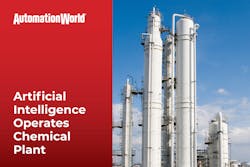Artificial Intelligence Operates Chemical Plant

Quick hits:
- Yokogawa’s reinforcement learning AI technology controls JSR chemical plant for 840 hours of operations.
- In addition to controlling operating parameters at the JSR plant, the AI ensured product quality while eliminating costs associated with the production of off-spec products.
- Top uses of AI among manufacturers include analysis of data from controllers, manufacturing execution systems, edge and cloud applications, and drive systems.
Welcome to Automation World’s Technology Matters. I’m David Greenfield, Director of Content, and today I’m going to tell you about how artificial intelligence has now been used to autonomously operate an operation at a large chemical plant and how artificial intelligence is being used more broadly across industry to analyze sensor data.
So, let’s start with the use of AI to run operations in the chemical plant. This test was done by Yokogawa Electric, working with chemical manufacturer JSR Corporation, to determine the viability of AI to successfully operate a distillation column at a JSR plant. The test ran from January 17 to February 21 of 2022, for a total of 840 hours—that’s 35 days’ worth of AI-controlled operations.
Yokogawa and JSR say the test confirmed that AI technology—in this case, a type of AI known as reinforcement learning—can control operations beyond automated PID and Advanced Process Control applications. Yokogawa says this AI technology can deal with conflicting targets, such as handling the dual needs of maintaining high quality and achieving energy savings.
According to Yokogawa and JSR, specific achievements of the AI technology during this test include: Ensuring product quality while eliminating costs associated with the production of off-spec products. Maintaining liquids in the distillation column at an appropriate level while maximizing use of waste heat as a heat source. And, during inclement weather that could disrupt the control state due to temperature changes, products produced during those periods still met the plant’s standards.
Though the test proved that complex chemical plant operations can be successfully controlled autonomously, Yokogawa and JSR point out that there are still many situations where veteran operators have to step in. Despite this, the test really shows the developing potential of AI for industrial operation applications.
Looking at more readily achievable applications of AI in manufacturing, Automation World recently conducted research of end users and system integrators about their use of AI to analyze sensor data. This is a key application of the technology for any Smart Manufacturing or Industry 4.0 initiative, because the expanding use of sensors in these applications can quickly accumulate more data than humans can ever effectively analyze. Plus, AI is particularly good at identifying the kinds of anomalies that people are likely to overlook, leading to better early detection of faults.
From our research, we learned that 26% of end users are currently applying AI to sensor data for production applications. And while 26% may seem like a low figure, given AI’s relative newness, this figure should be considered a good rate of uptake this early in the application of AI in manufacturing.
In terms of how manufacturers are using AI to analyze sensor data, system integrators say the top three applications they see are associated with controllers, manufacturing execution systems, and edge and cloud applications. End users agreed with system integrators in that controllers and MES technologies were among their top three applications of AI to sensor data, but for end users, instead of cloud and edge technologies, their other top use was associated with drive systems.
More specifically, end users say they’re using AI in these three areas for component and product inspection, overall asset health monitoring, identifying part and product positions on conveyors, quality inspections, and torque, temperature, and vibration analyses.
Integrators also pointed out how beneficial AI can be in asset health analyses. One said: “The real benefit comes from using AI to look at all the data—vision, temperature, flow, pressure, vibration, lubrication, corrosion, etc.—to provide a comprehensive assessment of asset health and remaining useful life.”
Another integrator noted that if they had to pick just one application of AI technology to sensor data that would be most useful to manufacturers, it would be for vibration monitoring of rotating equipment.
So I hope you enjoyed this Technology Matters episode. Keeping watching this space for regular updates on advances in and applications of industrial automation technology.
